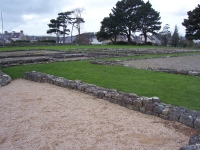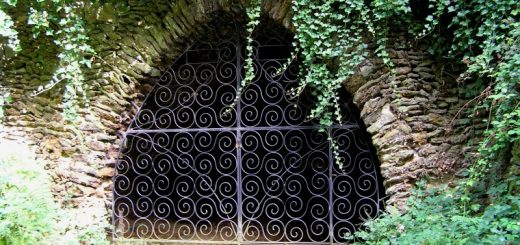The Hill of Tara
The Hill of Tara – ancient seat of the Kings of Ireland – is the focal point in a complex landscape of ancient monuments dating from the Neolithic to the Iron Age. It is a stirring setting where mythology and history fuse together, and has been revered as a holy site for thousands of years.
The actual hill itself – which only rises about 600 feet above sea level – is surrounded by an Iron Age defensive enclosure (consisting of an earthen ditch and bank) known as the Royal Enclosure or the Fort of Kings. This in turn surrounds two linked earthworks: a fort and a ring barrow known as Cormac’s House (Teach Chormaic) and the Royal Seat (Forradh).In the centre of the Royal Seat stands a pillar of granite that has been identified as the Irish Stone of destiny or the Lia Fail of Irish mythology: brought by the Tuatha De Dannan in the legendary history of Ireland. This stone was said to let out a roar that could be heard all over Ireland when touched by the hand of the rightful king.
The stone is not in its original position; it was placed in its current location to mark the grave of 400 rebels who died fighting British troops here on the 26 May 1798, during the bloody rebellion of that year.
To the North of the Royal enclosure is a ring fort consisting of three banks and ditches known as the Rath of the Synod. This was excavated at the turn of the century by the British Israelites, who believed – amongst other things – that the Ark of the Covenant was hidden here. They were unsurprisingly disappointed, but did uncover some Roman coins dating from the 1-3rd Century, perhaps dating settlement and trading at the site to that period.
Further North is a curious long and narrow earthwork known as the Banqueting Hall, the purpose of this is unknown but it may be related to other linear earthworks dating to the Neolithic and known as a cursus.
The oldest visible monument at the site is a short chambered passage grave known as the Mound of Hostages that is thought to date from around c.2500BC. Its name relates to the practice of Celtic kings taking hostages from smaller leaders within their kingdom to guarantee fealty. The mound was excavated in the 1950’s, only 1 of 2 sites at Tara to be explored: the other being the Rath of the Synod as fore mentioned.
Many of the names of the monuments at Tara suggest that the monuments were believed to date from Celtic times, and show how the mythology has fused with the history of the site.
In legend this is certainly the power base of the Tuatha De Dannan, and its religious importance can be seen both by the ritualistic monuments that are in abundance and by the legends and Christian mythology that has become part of the site.
For example in the 6th Century St Ruadhan is supposed to have put a curse on the land effectively ending kingship, but this may be a relatively recent story. St Patrick is also supposed to have visited Tara where he effectively defeated the Pagan priesthood. This could debatably be a folk memory of the older ways of kingship giving way to a more organised religion that was more church orientated, the site losing its complete hold on political and religious matters from this time? Perhaps one for the discussion boards.
Unfortunately the area is now under threat from development relating to the M3 Motorway some 2K from the Hill of Tara. Development at sites such as these seems a desecration after thousands of years of reverence and history. There may be discoveries relating to the landscape as a whole, just waiting to be discovered, which will be lost for ever with development. I wonder what Yeats would make of it?

![Nemoi [CC BY-SA 3.0 (https://creativecommons.org/licenses/by-sa/3.0)], from Wikimedia Commons](http://www.mysteriousbritain.co.uk/wp/wp-content/uploads/2018/12/Church_of_the_Hill_of_Tara-300x225.jpg)



Mound of Hostages
hails all,
The museum of History and Archaeology in Dublin has a nice exhibition of finds that were excavated from the Mound of Hostages, some amazing pottery and trinkets, well worth a visit.
waes hael
Dublin
I was in Dublin a few months ago and managed to get to the museum. Some of the finds there are amazing. The gold artifacts look like they were made a few weeks ago rather than a couple of thousand years.
Thanks for the heads up.